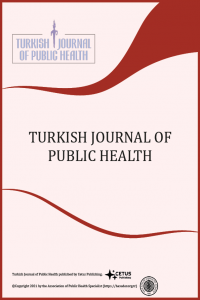Türkiye’de 2005-2014 yılları arasındaki ölüm/yaralanma ile sonuçlanan trafik kaza verilerinin değerlendirilmesi
Amaç: Bu çalışmanın amacı, Türkiye’de 2005-2014 yılları arasındaki ölümlü/yaralanmalı trafikkazalarını etkileyen risk faktörlerini araştırmaktır. Yöntem: Bu çalışma, Emniyet GenelMüdürlüğü’nün kayıtlarından elde edilen 2005-2014 yılları arasında gerçekleşen 1,656,403ölümlü/yaralanmalı kazadan analizlere uygun 1,201,203 vaka raporunu değerlendirmiştir.Bağımsız değişkenler, kazanın yeri ve zamanı, aracın tipi ve modeli, sürücünün sosyodemografik özellikleridir. Kazalardaki ölüm olayları bağımlı değişken olarak tanımlanmıştır. Herbir yıl için ölümlü kaza oluşumunu etkilediği düşünülen risk faktörleri lojistik regresyon modeloluşturularak araştırılmıştır. Ölümlü kazalara bağlı oluşan toplam ölüm sayısı ve yaralanmalıkazalarda meydana gelen toplam yaralı sayısı ve bu sayıları etkileyen risk faktörleri NegatifBinom ve Poisson regresyon modelleri kullanılarak irdelenmiştir. Bulgular: Ölümle sonuçlananvakaların yüzdesi %1.9’dur. Kazaya karışan sürücünün erkek olması ölümlü kaza riskiniarttırmaktadır. Veriden elde edilen sonuçlar göre öğrenim düzeyinin düşük olması, kazanınotobüs veya minibüs tipi araçlarda ve yerleşim yeri dışında gerçekleşmesi ölümlü kaza sayısınıarttırmaktadır. Sonuç: Sürücülerin bilgilendirilmesi ve trafik yasalarının etkili olarakuygulanması yakın gelecekte ölümlü kazaların azalmasına katkı sağlayacaktır.
Anahtar Kelimeler:
Trafik kazaları, ölümlü sonuç, kayıtlar, regresyon analizi
The evaluation of data on traffic accidents resulting in death or injury, between the years 2005-2014, in Turkey
Objective: The purpose of this study was to investigate the factors affecting road traffic death orinjury cases between the years 2005 and 2014 in Turkey. Methods: This study reviewed1,201,203 eligible case reports, out of 1,656,403 road traffic death or injury cases, from therecords of the Turkish National Police, between the years of 2005 and 2014. The independentvariables were; the location and time of the accidents; the type and model of the vehicles and thesocio-demographic characteristics of the drivers. The dependent variable was the presence of afatality in the accident. A logistic regression model was built to investigate the risk factorsaffecting the number of death cases for each year. Negative Binomial and Poisson regressionmodels were used to investigate the risk factors affecting the death cases and injury cases,respectively. Results: The percentage of cases which involved deaths was 1.9%. Being a maleincreased the risk of road traffic deaths. Data also showed that the number of deaths increasedin accidents where the drivers had lower educational levels, where larger vehicles were involved(e.g. busses), and where accidents took place outside residential areas. Conclusion: Informingthe drivers and implementing the traffic laws effectively will contribute to decreasing thenumbers of road traffic deaths in the near future.
Keywords:
Traffic accidents, fatal outcomes, registries,
___
- 1. WHO, Global Status Report on Road Safety. Geneva, Switzerland: WHO Press, World Health Organization,2015.
- 2. TUIK, Road Trafic Accident Statistics. Ankara, Türkiye: Turkish Statistical Institute, Printing Division, 2013.
- 3. Charbotel B, Chiron M, Martin JL, Bergeret A. Work-related road accidents in France. Eur J Epidemiol 2002;17(8):773–8.
- 4. Öz B, Özkan T, Lajunen T. An investigation of the relationship between organizational climate and professional drivers' driver behaviours. Safety Sci 2010;48(10): 1484–9.
- 5. Brijs T, Karlis D, Wets G. Studying the effect of weather conditions on daily crash counts using a discrete time-series model. Accid Anal Prev 2008;40(3):1180–90.
- 6. Loo BPY. Validating crash locations for quantitative spatial analysis: a GIS-based approach. Accid Anal Prev 2006;38(5): 879–86.
- 7. Tarko A, Thomaz J, Grant D. Probabilistic determination of crash locations in a road network with imperfect data. Transportation Research Record: Journal of the Transportation Research Board 2009;2102:76–84.
- 8. Fernandes R, Hatfield J, Soames Job RF. A systematic investigation of the differential predictors for speeding, drink-driving, driving while fatigued, and not wearing a seat belt, among young drivers. Transp Res F-Traf 2010;13(3):179–96.
- 9. Deniz Ö. Poisson regresyon analizi. İstanbul Ticaret Üniversitesi Fen Bilimleri Dergisi 2005; 4(7):59-72.
- 10. Sezgin FH, Deniz E. Poisson regresyon modelinde aşırı yayılım durumu ve negatif binomial regresyon analizinin Türkiye grev sayıları üzerine bir uygulaması. İstanbul Üniversitesi İşletme Fakültesi Yönetim Dergisi 2004;15(48):17-25.
- 11. Zhou JH, Qiu J, Zhao XC, Liu GD, Xiao K, Zhang L, Jiang ZQ, Wang ZG. Road crash in China from 2003 to 2005. Chi J Traumatol 2008; 11(1):3-7.
- 12. Pan SM, Chen EZ, Zhu SK, Layde P, Pirralo R, Hargarten S. Epidemiology characteristics of road traffic injury in China. Chin J Emerg Med 2005;14(9):709-14.
- 13. Zhou JH, Wang ZG. Research progress in traffic medicine in China. Chin J Trauma 2005;21(1):71-3.
- 14. Wang SM, Dalal K. Road traffic injuries in Shanghai, China. Health Med 2012;6(1):74–80.
- 15. Masoumi K, Forouzan A, Barzegari H, et. all. Effective factors in severity of traffic accident-related traumas; an epidemiologic study based on the Haddon Matrix. Emerg (Tehran) 2016;4(2):78–82.
- 16. Michalaki P, Quddus MA, Pitfield D, Huetson A. Exploring the factors affecting motorway accident severity in England using the generalised ordered Logistic Regression Model. J Safety Res 2015;55:89–97.
- 17. Polinder S, Haagsma JA, Lyons RA, et. all. Measuring the population burden of fatal and nonfatal injury. Epidemiol Rev 2012;34(1):17–31.
- 18. Alexandrescu R, O'Brien SJ, Lecky FE. A review of injury epidemiology in the UK and Europe: some methodological considerations in constructing rates. BMC Public Health 2009;9:226-37.
- 19. Karayolu Trafik ve Yol Güvenliği Derneği, istatistikler, yıllara göre sürücü sayısı Online. Erişim Adresi: http://www.trafik.org.tr/istatistikler/yillara-gore-surucu-sayisi. Erişim tarihi Ocak, 2017.
- Başlangıç: 2003
- Yayıncı: Halk Sağlığı Uzmanları Derneği
Sayıdaki Diğer Makaleler
Roma health in Edirne: Social determinants of health and health status
Muzaffer ESKİOCAK, Duygu AKBAŞAK
Hande ÜNLÜ, Burcu Küçük BİÇER, Hilal ÖZCEBE
Knowledge and practices of pharmaceutical laboratory workers on laboratory safety
Esra EMERCE, Bahar Güçiz DOĞAN
Hacer Özel DOĞAN, Birgül PİYAL
Determining primary school teachers’type 2 diabetes risk and healthy lifestyle behaviors
Hatice Serap Koçak, Selma Öncel, Handan Zincir, Emine Ümit Seviğ
The relationship between psychological symptoms and frequency of eating disorders in adolescents
Nazan Savaş, Tacettin İnandı, Evrim Arslan, Ersin Peker, Elif Durmaz, Mehmet Erdem, Ömer Alışkın, Arif Yeniçeri
